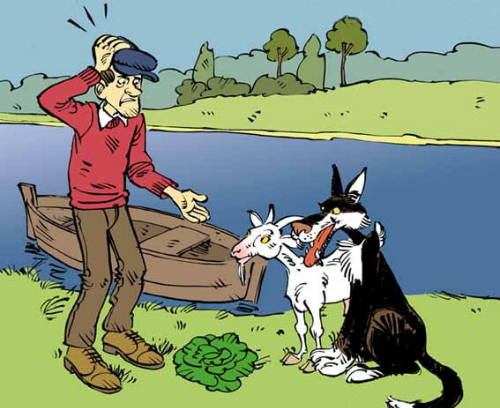Imagine standing at the edge of a river, faced with a puzzling situation: you’re a farmer with a wolf, a goat, and a cabbage, and you need to ferry them across the river. You have one small boat, but it can only carry you and one other item at a time. Here’s the twist—if left alone together, the wolf will eat the goat, and the goat will devour the cabbage. Can you figure out how to get all three across the river without any mishaps? Take a moment to think it over, but don’t worry if you get stuck; we’ll walk you through the steps to solve this classic riddle.
Common Pitfalls in Solving This Riddle

Riddles like this one are designed to test your logic, and it’s easy to fall into a few traps if you don’t think ahead. Here are some common missteps:
1. Overlooking Leftover Interactions
It’s tempting to think of each trip across the river individually, but the riddle demands that you manage what’s left on each bank. If you take the wolf across first, you risk leaving the goat alone with the cabbage, leading to an immediate “snack attack.”
2. Assuming the Most Dangerous Should Go First
Many people assume that since the wolf is dangerous, it should be transported first. However, this assumption doesn’t account for the risk of the goat eating the cabbage when left alone.
3. Focusing Only on Immediate Steps
The solution requires foresight, as some initial moves might seem correct but eventually lead to a situation that traps you. Planning out the sequence from start to finish is essential for success.
With these pitfalls in mind, let’s tackle the riddle one move at a time.
Step-by-Step Solution: Safely Cross the River
Follow along as we break down each move needed to ensure the wolf, goat, and cabbage all make it safely to the other side.
Step 1: Take the Goat Across
First, the farmer takes the goat across the river. This is a safe move since the wolf and the cabbage can be left alone without any risk of trouble—they won’t interact with each other.
Step 2: Return Alone
After leaving the goat on the far bank, the farmer returns alone to the original side. Now the goat is safe on the opposite bank, and the wolf and cabbage are still on the starting bank.
Step 3: Take the Cabbage Across
Next, the farmer takes the cabbage across the river. However, since leaving the cabbage alone with the goat would lead to disaster, the farmer takes the goat back to the starting side on the return trip.
Step 4: Return with the Goat
Leaving the cabbage safely on the far bank, the farmer brings the goat back to the original bank. This step ensures that the cabbage and goat are not left together unsupervised.
Step 5: Take the Wolf Across
Now, the farmer takes the wolf across the river. The cabbage remains on the far bank, and the wolf can be left there safely alongside it, as there’s no risk of the wolf disturbing the cabbage.
Step 6: Return Alone
After dropping off the wolf with the cabbage on the far bank, the farmer once again rows back alone to the original side, where the goat is waiting.
Step 7: Take the Goat Across
Finally, the farmer takes the goat across one last time. All three—the wolf, goat, and cabbage—are now safely on the opposite bank, with no animals or vegetables having fallen prey to each other along the way.is puzzle illustrates the importance of planning, a skill applicable to many real-world scenarios, from project management to strategic decision-making.
Challenge Yourself: Can You Think of Another Solution?
Did you come up with the same solution, or did you find yourself facing one of the common pitfalls? Maybe you tried a different approach that didn’t quite work. If so, you’re not alone—this puzzle has tricked people for generations! Feel free to share your thoughts or alternative strategies in the comments. We’d love to hear how you approached the puzzle and if you spotted the key moves early on.
Final Thoughts: The Joy of Logic Puzzles
Logic puzzles like this one aren’t just entertaining; they’re exercises in mental agility. By challenging us to think several moves ahead and consider multiple variables, riddles help sharpen our problem-solving skills. They teach us to be mindful of details and remind us that sometimes, the solution is simpler than it initially seems—once we shift our perspective and think a few steps ahead.
If you enjoyed this classic riddle, why not try more? Each puzzle offers a unique twist and the opportunity to grow your critical thinking skills. The more you practice, the more you’ll train your mind to see patterns and develop solutions with ease. Happy puzzling!


